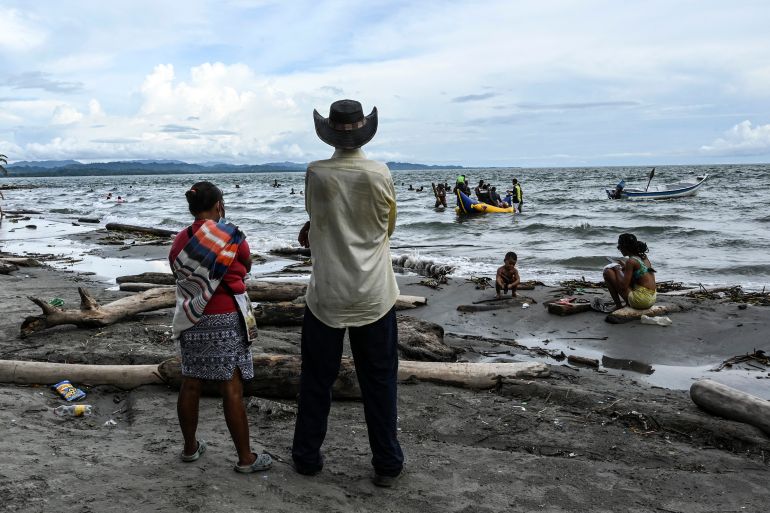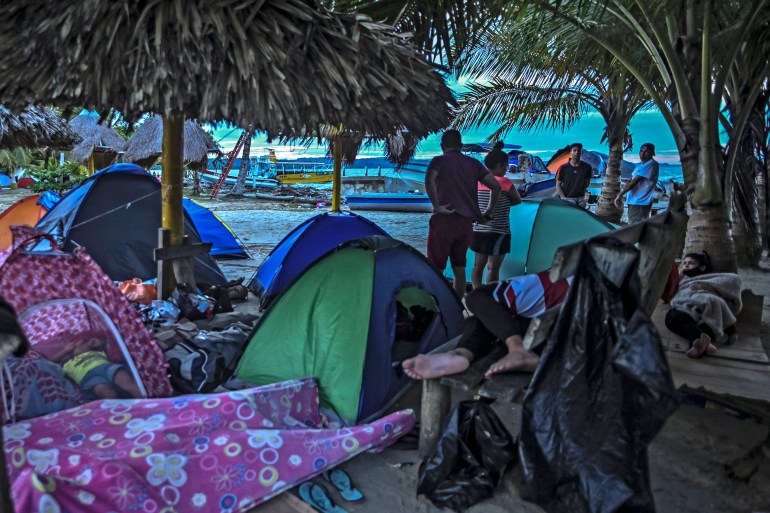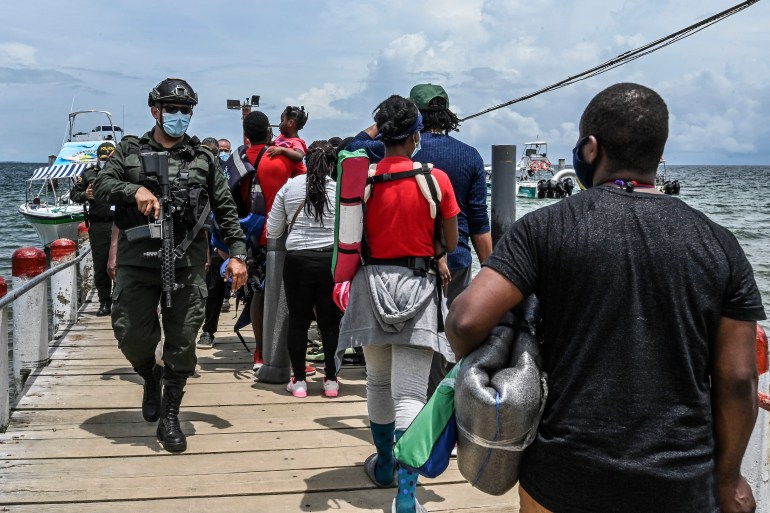Migrants stranded in northern Colombia struggling to survive
Colombia and Panama to hold a meeting on Monday to discuss the passage of thousands of migrants stranded in the border region.

Migrants and asylum seekers are struggling to survive in a port town in northern Colombia from where they are hoping to continue on their journeys towards the United States and Canada.
For years, the coastal town of Necocli, in Colombia’s Antioquia province, has been a key transit point for migrants seeking to cross Panama’s dangerous Darien Gap region northwards in search of protection and better opportunities.
Keep reading
list of 4 itemsNearly 400 migrants rescued in Mediterranean Sea
Boat capsizes off Western Sahara, 42 migrants feared dead
Migrant deaths nearly doubled in first half of 2021
That influx dried up in 2020 due to COVID-19 restrictions and border closures, but Necocli was overwhelmed soon after Colombia opened its frontiers in May. About 10,000 migrants have since flooded into the town, with many forced to wait for weeks for scarce boat transport to Panama.
“I’ve only got $150 left … it’s going to be almost impossible to go any further,” Haitian migrant Remi Wilford told the AFP news agency this week.
Wilford arrived in Necocli from Chile, where he had saved up $1,200 over the last four years working as a baker. He took two weeks to arrive and has been waiting another two weeks to board a boat that will take him to the border with Panama.
There are 12 daily boat trips across the 60km (37 miles) Gulf of Uraba from Necocli to the Panama border town of Capurgana, where migrants begin the dangerous journey through the thick jungle of the Darien Gap.
The only company in Necocli offering boat crossings simply cannot match demand, forcing migrants to spend their precious savings on food and lodging while waiting to move on.
Reporting from Necocli on Saturday, Al Jazeera’s Teresa Bo said while many migrants have been able to cross, “they’re still arriving here, and municipalities on the other side of the Gulf of Uraba … are only allowing 200 people a day [to cross]”.
She said many migrants say they just want to be allowed to continue on their journeys. “These people are stranded currently. They say they have no resources, that they have no money, and they’re struggling in a way to survive,” Bo said.
The Necocli region typically sees 30,000 migrants pass through annually. Just 4,000 people transited through in 2020, while 25,000 migrants have transited so far this year, according to Colombia’s migration agency.
The United Nations’ child’s rights agency said in March that the number of children moving through the Darien Gap increased by more than 15-fold over the past four years, while children accounted for 25 percent of all migrants in 2020.

“I’ve seen women step out of the jungle carrying their babies in their arms after walking for more than seven days without water, food or any kind of protection,” Jean Gough, UNICEF’s regional director for Latin America and the Caribbean, said in a statement at that time.
“These families are pushing their own limits and putting their lives in danger, often without realising how much of a risk they are taking. Those who manage to eventually cross this perilous border are physically and mentally devastated. Their humanitarian needs are immediate and immense.”
But Bo said the dangers have not deterred many migrants still stuck in northern Colombia.
“In spite of all the risks that they could encounter, they still say that they need to continue with their journey, that they need to get to a place where they will get a better life, but they will [also] be able to help their relatives back home, whether in Haiti, Africa, Cuba or anywhere else,” she said.
Meanwhile, the foreign ministers of Colombia and Panama said on Friday they would work together to process and organise thousands of migrants stranded for long periods in northern Colombia.

A meeting is scheduled for Monday, Colombian Vice President and Foreign Minister Marta Lucia Ramirez said after meeting with her Panamanian counterpart in Meteti, Panama.
The discussions will “define how we are going to regularise a contingent, a daily quantity of people who preferably would move through one single site, have one single arrival point in Panama and move on transport that is organised and controlled by Colombian authorities”, Ramirez said.
Organising the migrants and improved planning for transport and travel routes will help protect them from criminals, drowning risks and the dangers of the Darien Gap, she said, adding human trafficking often goes hand-in-hand with drug smuggling.